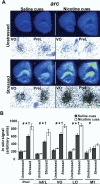Acute stress and nicotine cues interact to unveil locomotor arousal and activity-dependent gene expression in the prefrontal cortex
- PMID: 16631128
- PMCID: PMC1698504
- DOI: 10.1016/j.biopsych.2006.03.002
Acute stress and nicotine cues interact to unveil locomotor arousal and activity-dependent gene expression in the prefrontal cortex
Abstract
Background: This study examines the interactive effects of acute stress and nicotine-associated contextual cues on locomotor activity and activity-dependent gene expression in subregions of the prefrontal cortex.
Methods: Locomotor activity of rats was measured in a context associated with either low-dose nicotine or saline administration with or without 5 minutes of pre-exposure to ferrets, a nonphysical stressor. After 45 minutes in the test environment, plasma corticosterone levels and mRNA levels of the immediate-early genes Arc, NGFI-B, and c-Fos in prefrontal and primary motor cortical subregions were measured.
Results: Stress alone increased plasma corticosterone and prefrontal cortex gene expression. Low-dose nicotine cues had no effect on corticosterone levels nor did they elicit conditioned motor activation, and they caused minor elevations in gene expression. Stress and low-dose nicotine cues, however, interacted to elicit conditioned motor activation and further increases in early response gene expression in prefrontal but not in the primary motor cortical subregions.
Conclusions: Stress interacts with nicotine-associated cues to uncover locomotor arousal, a state associated with prefrontal neuronal activation and immediate early gene expression. Thus, in nicotine-experienced individuals, stress may be an important determinant of subjective reactivity and prefrontal cortex activation that occurs in response to nicotine-associated cues.
Figures





Similar articles
-
A comparison of two immediate-early genes, c-fos and NGFI-B, as markers for functional activation in stress-related neuroendocrine circuitry.J Neurosci. 1993 Dec;13(12):5126-38. doi: 10.1523/JNEUROSCI.13-12-05126.1993. J Neurosci. 1993. PMID: 8254363 Free PMC article.
-
A common profile of prefrontal cortical activation following exposure to nicotine- or chocolate-associated contextual cues.Neuroscience. 2001;105(3):535-45. doi: 10.1016/s0306-4522(01)00221-4. Neuroscience. 2001. PMID: 11516821
-
Contextual cues associated with nicotine administration increase arc mRNA expression in corticolimbic areas of the rat brain.Eur J Neurosci. 2005 Mar;21(6):1703-11. doi: 10.1111/j.1460-9568.2005.04001.x. Eur J Neurosci. 2005. PMID: 15845097 Free PMC article.
-
Biphasic changes in locomotor behavior and in expression of mRNA for NGFI-A and NGFI-B in rat striatum following acute caffeine administration.J Neurosci. 1995 Nov;15(11):7612-24. doi: 10.1523/JNEUROSCI.15-11-07612.1995. J Neurosci. 1995. PMID: 7472512 Free PMC article.
-
Acetaldehyde, a major constituent of tobacco smoke, enhances behavioral, endocrine, and neuronal responses to nicotine in adolescent and adult rats.Neuropsychopharmacology. 2007 Sep;32(9):2025-35. doi: 10.1038/sj.npp.1301327. Epub 2007 Feb 7. Neuropsychopharmacology. 2007. PMID: 17287824
Cited by
-
Nur transcription factors in stress and addiction.Front Mol Neurosci. 2013 Dec 2;6:44. doi: 10.3389/fnmol.2013.00044. Front Mol Neurosci. 2013. PMID: 24348325 Free PMC article. Review.
-
Molecular mechanisms underlying the motivational effects of nicotine.Nebr Symp Motiv. 2009;55:17-30. doi: 10.1007/978-0-387-78748-0_3. Nebr Symp Motiv. 2009. PMID: 19013937 Free PMC article. Review.
-
Working memory- and anxiety-related behavioral effects of repeated nicotine as a stressor: the role of cannabinoid receptors.BMC Neurosci. 2013 Feb 9;14:20. doi: 10.1186/1471-2202-14-20. BMC Neurosci. 2013. PMID: 23394117 Free PMC article.
-
Fos expression following regimens of predator stress versus footshock that differentially affect prepulse inhibition in rats.Physiol Behav. 2011 Oct 24;104(5):796-803. doi: 10.1016/j.physbeh.2011.08.001. Epub 2011 Aug 6. Physiol Behav. 2011. PMID: 21843541 Free PMC article.
-
Interrelated involvement of the endocannabinoid/endovanilloid (TRPV1) systems and epigenetic processes in anxiety- and working memory impairment-related behavioural effects of nicotine as a stressor.Addict Biol. 2024 Jul;29(7):10.1111/adb.13421. doi: 10.1111/adb.13421. Addict Biol. 2024. PMID: 38963015 Free PMC article.
References
-
- Adamec R. Does long term potentiation in periacqueductal gray (PAG) mediate lasting changes in rodent anxiety-like behavior (ALB) produced by predator stress?-Effects of low frequency stimulation (LFS) of PAG on place preference and changes in ALB produced by predator stress. Behav Brain Res. 2001;120:111–135. - PubMed
-
- Bevins RA, Besheer J, Pickett KS. Nicotine-conditioned locomotor activity in rats: Dopaminergic and GABAergic influences on conditioned expression. Pharmacol Biochem Behav. 2001;68:135–145. - PubMed
-
- Bevins RA, Palmatier MI. Nicotine-conditioned locomotor sensitization in rats: Assessment of the US-preexposure effect. Behav Brain Res. 2003;143:65–74. - PubMed
Publication types
MeSH terms
Substances
Grants and funding
LinkOut - more resources
Full Text Sources

